STS-1
|
Int. Designation |
1981-034A |
|
Launched |
12 April 1981 |
|
Launch Site |
Pad 39A, Kennedy Space Center, Florida |
|
Landed |
14 April 1981 |
|
Landing Site |
Runway 23, Edwards Air Force Base, California |
|
Launch Vehicle |
OV-102 Columbia/ET-2/SRB A07; A08/SSME #1 2007; |
|
#2 2006; #3 2005 |
|
|
Duration |
2 days 6 hrs 20 min 53 sec |
|
Callsign |
Columbia |
|
Objective |
First manned orbital test flight (OFT-1) of Shuttle system |
Flight Crew
YOUNG, John Watts, 50, USN, commander, 5th mission
Previous missions: Gemini 3 (1965); Gemini 10 (1966); Apollo 10 (1969);
Apollo 16 (1972)
CRIPPEN, Robert Laurel, 43, USN, pilot
Flight Log
The build up to this momentous space mission for the US programme was painfully slow. A budget lower than that afforded to Apollo for a space system five times more technically demanding resulted in inevitable glitches at almost every turn. The first space flight by the Space Shuttle was originally scheduled for 1978, but in fact all that happened was that the first four space crews were rather optimistically named for missions that would start the following year. Thus, veteran John Young and rookie Bob “Crip” Crippen began what was to become one of the longest periods of training ever, ending with a lift-off in 1981. Coincidentally, for such a major space milestone, the launch would be on the twentieth anniversary of the first manned space flight by Yuri Gagarin.
That the launch had been scrubbed at T — 36 min, by a computer synchronisation glitch two days before, which had been dubbed by the media assembled at the Kennedy Space Center as a “fiasco”, is indicative of the reputation of the Shuttle. The USA had been through a period of several major technical disasters, including Three Mile Island, and there were many cynics expecting to be reporting another from the Kennedy Space Center on a maiden flight being manned for the first time. There is no doubting the heroism of the crew, who had only the dubious opportunity of ejection seats available to them for an early bail-out.
The cataclysmic blast-off occurred at 07: 00 hrs local time, causing unpredicted over pressurisation of the orbiter and a potential collision with the launch tower, followed almost immediately by the roll programme which alarmed already nervous
![]()

The Third Decade: 1981-1990
spectators with its brute force. Thrust was five per cent higher than anticipated, leading to a steeper, “heads down” climb to orbit. The solid rocket boosters were ejected at T + 2 minutes 11 seconds and the three main engines cut off at T + 8 minutes. The Space Shuttle Columbia was in initial orbit and was then boosted by four burns of the orbiter’s own propulsion system. Inclination was 40.3° and maximum altitude 232 km (144 miles).
With Columbia flying “upside-down” with its back facing the Earth, the payload bay doors were opened, exposing a vast interior which was empty for this test flight. TV cameras also showed that some heatshield tiles were missing from the rear of the orbiter and much was made of this in the popular press. They were not critical tiles, but all the same if they were missing, could other more critical tiles on the orbiter’s underside be loose or lost? The crew would find out after their thirty-sixth orbit, when after an almost flawless orbital workout by the jubilant Young and Crippen, the OMS engines initiated the 2 minute 27 second long retro-fire burn.
The Mach 25 re-entry, during which some tiles were exposed to 1,260°C, was accompanied by the usual radio blackout. Then, at Mach 10 and 57.3 km (36 miles), the happy Young reported that all was well. He proceeded to bring Columbia in like an airliner, landing on the dry lake bed runway 23, at Edwards Air Force Base, with main gear touchdown at T + 2 days 6 hours 20 minutes 32 seconds. Routine space flight with airliner-like landings seemed to have begun. Fifty Shuttle flights a year were being predicted.
Milestones
80th manned space flight 32nd US manned space flight 1st Shuttle mission 1st flight of Columbia
1st manned space flight in a reusable spacecraft
1st manned space flight on previously untested spacecraft
1st manned space flight to be boosted by solid propellants
1st flight by crewman on fifth space mission
1st flight to end with conventional runway landing

 |
Flight Crew
POPOV, Leonid Ivanovich, 35, Soviet Air Force, commander, 2nd mission Previous mission: Soyuz 35 (1980)
PRUNARIU, Dumitru Dorin, 28, Romanian Army Air Force, cosmonaut researcher
Flight Log
The final Interkosmos mission involving a cosmonaut researcher from a Soviet bloc country, Soyuz 40, was also the last of this Soyuz model. Crewed by Leonid Popov and Dumitru Prunariu, the mission got under way at 23: 17hrs from Baikonur, followed by the docking with Salyut 6 a day later and greetings from residents Kovalenok and Savinykh. Experiments on board included those to study the Earth’s upper atmosphere and changes in its magnetic field. The mission ended at T + 7 days 20 hours 41 minutes 52 seconds, 224 km (139 miles) southeast of Dzhezkazgan. Maximum altitude during the 51.6° mission was 374 km (232 miles).
When Soyuz T4 returned later, Salyut 6 had received 16 cosmonaut crews and 15 unmanned spacecraft in three-and-a-half years. No fewer than 35 dockings had been made with it and Salyut 6 was occupied for 676 days. Some 13,000 photographs of the Earth had been taken and 1,310 experiments operated a remarkable record.
Milestones
81st manned space flight
49th Soviet manned space flight
42nd Soyuz manned space flight
39th (original) Soyuz manned space flight
Final flight of original Soyuz variant
1st manned space flight by a Romanian
9th and final Interkosmos mission
|
|
Prunariu (right) wears the Chibis lower body negative pressure garment aboard Salyut 6, assisted by Popov











